 Gonna wait till the midnight hour, when there's no one else around. 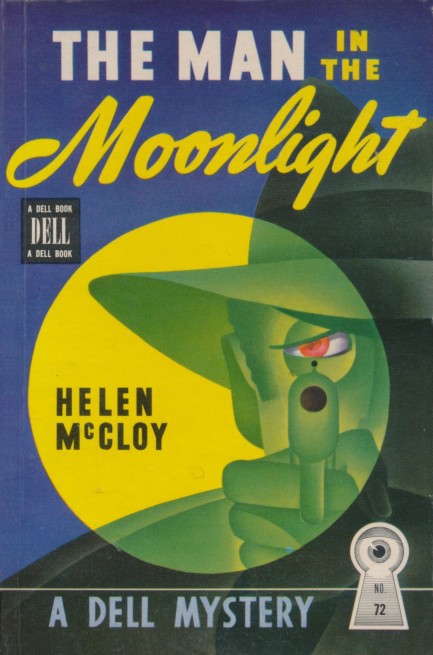
 Above you see a cover effort by Gerald Gregg for Helen McCloy's 1945 mystery The Man in the Moonlight. This is from Dell Publications, and you probably recognized it right away as a mapback edition. You see that here too, with its fictive university campus. Above you see a cover effort by Gerald Gregg for Helen McCloy's 1945 mystery The Man in the Moonlight. This is from Dell Publications, and you probably recognized it right away as a mapback edition. You see that here too, with its fictive university campus.
The story is a variation of a locked room mystery, however it requires more than the usual helping of suspension of disbelief from readers. Basically, a university psychologist stages an experiment that's, more than anything, a form of live action role playing in which a colleague is to attempt to achieve the circumstances needed to commit a murder. But the psychologist is really testing more than his willing maze rat suspects, which is why in the midst of the experiment the parameters suddenly change in a way designed to induce panic. We won't get into the ethics of that.
It's during this emotional experiment that the murder occurs, and it just happens that police detective Patrick Foyle is on campus when it happens. He's on the case in seconds, but much of the investigation (and narrative) falls to a psychiatrist named Basil Willing. Between cop and headshrinker the culprit will out, as they always do. We didn't really buy any of it, but we did like the fact that the story was set in 1940 and brought in the specter of Nazi involvement. Here's a fun line: Even in the infinitely remote world of the molecule [no-spoiler] ran afoul of Nazi policy. It's always been true—fascists get their noses deep into everything.
 Powell shoots for a comedic mystery but doesn't have Hammett's perfect aim. 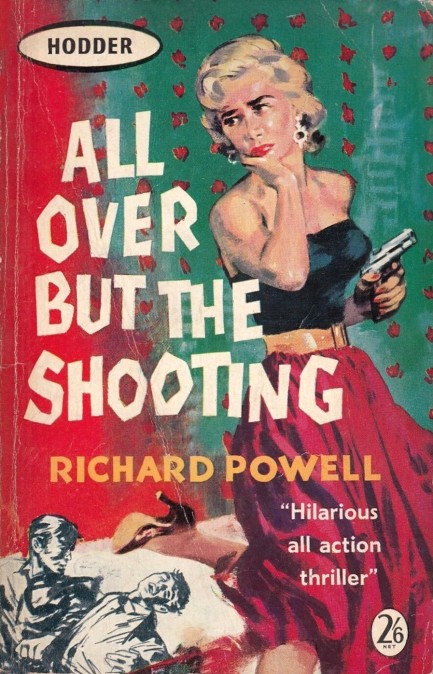
What is a "hilarious all-action thriller" like? That's the question that went through our minds when we impulsively ordered Richard Powell's 1946 novel All Over but the Shooting, though we were also drawn by the cover. The book was originally published by Popular Library, but the striking version you see above with art that's unfortunately uncredited came from the British imprint Hodder & Stoughton in 1952. Powell weaves a tale set in 1942 about Richard Blake and his danger-magnet wife Arabella—Arab for short—who believes she's stumbled across a spy plot centered around a Washington, D.C. women's boarding house. Determined to delve for answers—and to her husband's chagrin—she pretends to be a single woman, takes a room, and starts poking around. Her suspicions are of course correct. The place is a den of Nazis.
Powell thinks outside the box about every aspect of his story: how the conspiracy is uncovered, how the investigation proceeds, what clues are found, and what leaps of intuition keep the intrepid Arabella moving toward a solution. But the entire story is preposterous. Example: when Arab seems likely to be connected to a raincoat she lost while fleeing for her life, her hubby manages to sneak into the room where it's being kept—while its occupant is just upstairs—and have it altered in five minutes by a conveniently situated maid. That way the coat won't fit Arab when the villain tries to say it's hers.
That and about two dozen other moments are silly. Powell achieved, we think, exactly what he set out to do as an author, but we didn't find the book to be exactly scintillating. It was no Thin Man, for example, Dashiell Hammett's smashingly successful amalgam of humor and danger. But in the same way Arab erodes her husband's disbelief and finally gets him to buy into her wacky ideas, she wore us down too. She's a fun character, and makes the book worth a read. We won't seek out Powell again, but one spin around wartime D.C.? Sure, okay.

 Toto we’re not in Africa anymore. 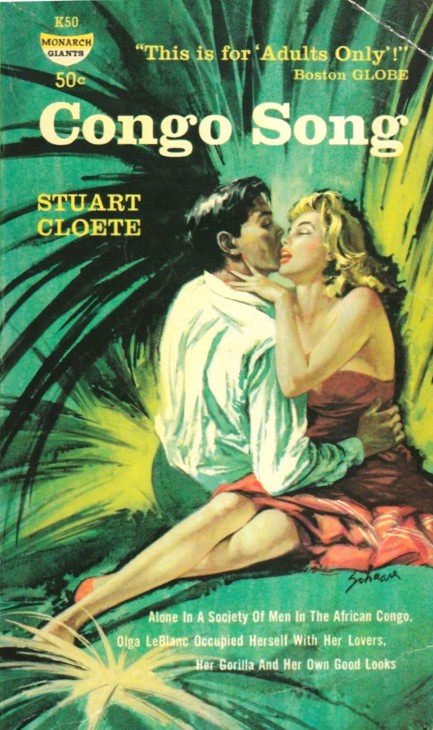
We said we'd get back to Stuart Cloete’s 1943 jungle drama Congo Song, and here we are. The book has been reprinted often, including in the 1958 Monarch edition you see above, with Harry Schaare cover art. Its popularity certainly owed something to the fact that it was another book that nurtured popular Western stereotypes about life in Africa, including that it attracted decadent and damaged whites whose weaknesses were inevitably amplified by the deep, dark, primitive, savage, mysterious continent. You've read something like this once or twice, we bet, thanks to Hemingway and others, though Cloete, who was from South Africa, writes in an entirely different style than Papa:
This was the Congo song: the song of sluggish rivers, of the mountains, the forests; the song of the distant, throbbing drums, of the ripe fruits falling, of the mosquitoes humming in the scented dusk; the song of Entobo, of the gorilla, and the snake. The song no white man would ever sing. The wild dogs cry out in the night as they grow restless, longing for some solitary company. Oops—that last sentence is from the Toto song “Africa.” Don't know how that slipped in there. Anyway, Congo Song unfolds in the months before the start of World War II. Cloete’s characters are diverse, with his main creation being Olga le Blanc, the only woman living in an isolated outpost called Botanical Station with several men, including her husband, a researcher who spends a lot of time away. Olga is a vamp who must make other men fall in with love her, and her affections don't end at homo sapiens sapiens—she has a gorilla, unsubtly named Congo, that she nursed at her own breast when it was an infant. Cloete’s symbolism is pretty thick milk. Erudite conversation, circular philosophizing, seductions, and secrets abound at Botanical Station. One of the other main characters is an American named Henry Wilson who has been sent by handlers in Nairobi to keep an eye on the doings of a German spy named Fritz von Brandt. Olga, meanwhile, spies on von Brandt for the English—sometimes from his bed. Other characters have less purpose, and many eccentricities. One drinks too much. Another sleeps with teenaged Congolese girls under the guise of employing them as domestics. The researcher seems to love trees more than Olga. Nobody is particularly happy. Who is who? Who wants what? There's another spy, who we won't name, a machine-like man, asexual, immune even to Olga: Women were the weakness of so many. Money, luxury, power, all resolved themselves finally into women. That was where the money went. That was what the power was used to obtain. How lucky he was to have been born without sexual feelings. All the duplicity in Congo Song derives from the looming war in Europe, but there's also another driver: “Under all this,” Olga observes, “is the never-ending fight for the riches of Africa.”
Despite all the dinners, safaris, subterfuges, and soliloquies—or maybe because of the soliloquies—the book doesn't gather momentum until about page two-fifty, after a fatal accident. Then things move fast enough to cause whiplash. Death comes by various methods, none of them banal. And of course there's still that gorilla. He lives in the house with the le Blancs, but Olga lets him loose regularly. Surely that'll end with limbs separated from bodies and blood on the louvered doors. And Cloete clearly must—absolutely must—squeeze in a little lethal witch-doctoring. No more plot hints. However, it isn't a spoiler to reveal that since Cloete follows the basic blueprint of other books of this type, at least a character or two eventually flee for modern civilization. But they'll remember Congo with bittersweet nostalgia—primarily during a maudlin denouement drawn out over several chapters. But it's understandable—it's not easy to let go of such beauty and horror. Not easy to let go of Congo Song either. It wasn't perfect, but it was very interesting. It’s gonna take a lot to take me awaaaay from yoooou… There’s nothing that a hundred men or moooore could ever doooo… I bless the rains down in Aaaafricaaa… 
 You never know when your time is up. Usually. 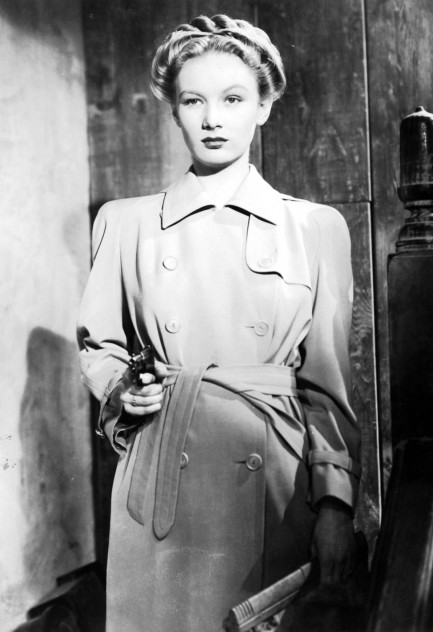
Above: Veronica Lake stars in a menacing promo photo made for her 1944 spy movie The Hour Before Dawn. She plays a pure femme fatale, a bad woman living in London as a double agent in the employ of the Third Reich. The movie was poorly reviewed, but we give this image five stars.
 Proceed with caution—Nazi crossing. 
Marjorie Reynolds gives her best transfixed look in this promo image made for her 1944 film noir Ministry of Fear. The swastika leaves no doubt who the villains are. They take over a New York City brownstone and use it as a base of operations for various dastardly doings. The film is uneven despite being helmed by the legendary Fritz Lang. Reynolds, who also acted under her real name Marjorie Goodspeed, as well as Marjorie Moore, appeared in dozens of movies but wasn't quite what you'd call a star. Her signature moment probably came when she sang the song, “White Christmas,” in the 1942 film Holiday Inn. She performed it twice—once solo, and once as a duet with Bing Crosby. She didn't appear in many crime movies or thrillers, so we probably won't see her here again, but this is quite a shot to go out on. You can read what we wrote about Ministry of Fear here.
 Swiss bank receives long deserved exposure thanks to data leak. 
We're occasionally asked why we don't do modern true crime write-ups as often as we once did. There are a couple of reasons. We actually have jobs, and the research on crime stories is time consuming. But secondly, modern day swindles, scams, and corruption are out of control to the extent that writing about them seems redundant. But we're making an exception today because one of our previous subjects, who we wrote about way back in 2009, has popped up in the news again. That would be Hisham Talaat Moustafa, who was sentenced to death for hiring out the murder of his ex-girlfriend, Lebanese pop star Suzanne Tamim. His was one of thousands of names just revealed in a massive financial data leak from Credit Suisse, one of the most prestigious banks in Switzerland, which hides money for the richest people in the world.
We think everyone knows Swiss banks are corrupt, right? Their first secrecy laws were adopted in 1713. It's safe to say they've been corrupt for almost that long. Over the years Credit Suisse's clients have included Ferdinand and Imelda Marcos, who stole $10 billion from the Philippine treasury, Romanian dictator Nicolae Ceausescu, Panamanian drug lord and CIA informant Manuel Noriega, thousands of Nazis who were hiding their expropriations, and countless shady shell companies. One can insert the usual objections about taxes here, but the point is that regular people must pay them, yet the rich and powerful somehow always manage to avoid their fair share, even when they've generated their loot through illegal or even genocidal means. As with many morally rudderless institutions and people, what Swiss banks do is perfectly legal, but “perfectly legal” is the phrase uttered by people who know they're willfully engaged in behavior that obviously should be illegal—and in fact is illegal for everyone but the rich and connected. people must pay them, yet the rich and powerful somehow always manage to avoid their fair share, even when they've generated their loot through illegal or even genocidal means. As with many morally rudderless institutions and people, what Swiss banks do is perfectly legal, but “perfectly legal” is the phrase uttered by people who know they're willfully engaged in behavior that obviously should be illegal—and in fact is illegal for everyone but the rich and connected.
Credit Suisse is trying to pretend that the leak reveals old accounts from before the bank cleaned up its practices (which it never substantially did), but the spin won't be effective because the data reveals that the bank is currently holding money for human traffickers, drug lords, oligarchs, stock cheats, treasury looters, mafia kingpins and—in the case of Hisham Moustafa—murderers. Correction—pardoned murderers, since he was released thanks to presidential decree in 2017. The information on all this corruption was originally passed to the German newspaper Süddeutsche Zeitung via an anonymous whistleblower, and the odds are good that in a matter of weeks or months that currently unknown person will be outed and have to make a full time job of trying to avoid the total destruction of his or her life and a prison sentence—no pardon pending.
Tax and corruption problems have exploded globally as elite greed has grown, the profits from criminality have soared, digital technology has created previously-unheard-of fortunes, offshoring of profits has become standard practice, deregulation and the de-facto dissolving of anti-trust laws have allowed corporations to grow more powerful than countries, and austerity has shrunk or eliminated the enforcement mechanisms of public institutions. In fact, in addition to funneling money from regular people to corporations and the rich, the other point of austerity is to shrink government to prevent it prying into the affairs of corporations and the rich. Libertarians rejoice. Insider trading, commodities fraud, and money laundering are all now rampant, and there's nothing people can do about it because the government institutions meant to be centers of oversight were taken over by the rich decades ago.
Moustafa paid to have his girlfriend knifed to death. Unlike murderers able to hide behind the fig leaf of non-conviction, his guilt was established as a fact during a criminal court proceeding. He was sentenced to hanging but was retried and had his punishment reduced to a mere fifteen years. He spent, in total before his pardon, nine years in a country club prison, and all the while managed his wealth, built up his billions, and came out of jail not disgraced and shunned, but welcomed, feted, and once again demanding and receiving VIP treatment, the best tables in the best restaurants, and the ear of the global elite. He threw a few coins to charity along the way to spit-shine his reputation, had his thriving conglomerate Talaat Moustafa Group donate some COVID vaccines, but still he's a murderer who wriggled loose from the hangman's noose, and today enjoys every privilege he ever enjoyed—while his victim is dead forever. came out of jail not disgraced and shunned, but welcomed, feted, and once again demanding and receiving VIP treatment, the best tables in the best restaurants, and the ear of the global elite. He threw a few coins to charity along the way to spit-shine his reputation, had his thriving conglomerate Talaat Moustafa Group donate some COVID vaccines, but still he's a murderer who wriggled loose from the hangman's noose, and today enjoys every privilege he ever enjoyed—while his victim is dead forever.
This is the place in which we find ourselves. We all understand, if we actually absorb factual information rather than apologist propaganda or fanciful myth, that the rich have fucked up this world, and the rest of us, as well as future generations, are going to pay to clean up the mess. If it can even be cleaned up, which is doubtful. And that's why we stopped writing about modern crime and corruption. It's pointless. It's banal. Writing about old crimes is an escape, a window into history and the mad hearts of men and women who are long, long gone. Writing about current crimes is self-flagellation. We'll still do it on occasion when the urge strikes, like today, but we're well aware that people tend to complain more as time goes by and we don't want to fall into that trap. We want Pulp Intl. to be a place of entertainment and wonder—by which we mean amazing art, exciting fiction, bizarre historical and Hollywood facts, and beautiful women.
 The king of tabloids sets its sights on the Queen of Greece. 
Every month when Confidential magazine hit newsstands, we imagine Hollywood celebrities receiving the bad news that they'd made the cover, and going, “Shit.” This issue published in January 1964 features Elizabeth Taylor, Richard Burton, Frank Sinatra, and Jill St. John. The first three members of that group probably took the news in stride, since they were all tabloid staples by then. St. John wasn't quite at their level, but her links with Sinatra kept her in the scandal sheets for a while too.
A person who wasn't used to Confidential's attentions was Frederica of Hanover, who at the time was Queen Consort of Greece—which is just a fancy way of saying she was married to the King of Greece. Confidential says she was a Nazi, a pretty serious charge, needless to say. Was she? Well, her grandfather was Kaiser Wilhelm II, as a girl she was a member of Bund Deutscher Mädel, which was a branch of the Hitler Youth, and she had brothers in the SS. Also, back in 1934 Adolf Hitler wanted to link the British and German royal houses, and tried to pressure Frederica's parents into arranging for the seventeen-year-old girl to marry the Prince of Wales, Edward VIII. And as Queen Consort she made a habit of meddling in Greek politics in ways that made clear she was not a fan of democracy. None of that is a particularly good look.
She had defenders, though, who believed that for a person in her position it would have been impossible not to have been a member of certain groups and to have socialized with Nazis. It's interesting, isn't it, how the rich and powerful always benefit from a special set of excuses? People can't really expect her to have made a stand, can they? But the excuse is hollow. As a high ranking royal she could have avoided anything she wished. Membership in organizations when she was a little girl is one thing, but as an adult she could have denounced Nazism with damage to her reputation the only potential result. A damaged reputation is no small thing, but if we expect resistance from people who'd have been imprisoned or shot for doing so, we should probably expect the same from people who would have suffered mostly dirty looks.
Confidential focuses on Frederica's July 1963 visit to England. The visit was no big surprise—Frederica, her husband King Paul of Greece, Queen Elizabeth, and her husband Prince Philip, were all related. They were all direct descendants of Queen Victoria. Monarchy is a funny thing, isn't it? The visit triggered a protest of about three thousand British leftists that was violently broken up by five thousand police. The protestors carried banners that said, “Down with the Nazi Queen.” After mentioning this fiasco, Confidential delves into Frederica's history, some of which we've outlined above, then loops back to the protests, which she blamed on the British press. But she had already reached a level of notoriety that usually brought out protestors who loudly booed her, particularly in Greece. She eventually retreated from public life, became a Buddhist, and died early at age sixty-three.
Confidential's unexpected exposé on Frederica wasn't out of character for the magazine. It was the top tabloid dog in a very large kennel. It had an expansive staff, serious reporters, hundreds of informers spread across the U.S. and Britain, and published stories about heavy hitters from all sectors of society. It had a regressive political agenda, as its article filled with terrible slander against gays and lesbians makes clear, but even with its rightward slant it took pains to keep its reporting framework factual. That makes it a priceless source of contemporaneous info about public figures, particularly of the Hollywood variety. We doubt we'll ever stop buying it, because we never know who we'll find inside. Twenty-plus scans below.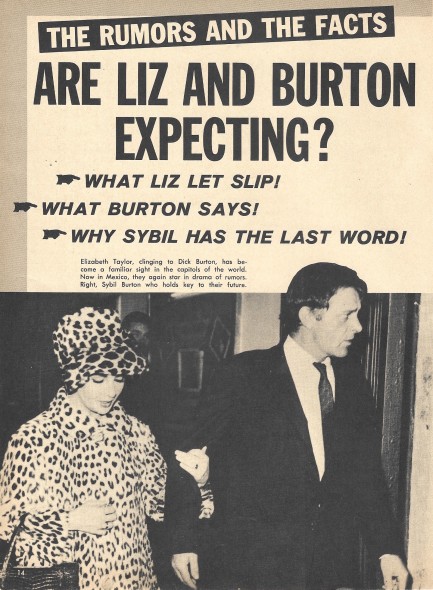 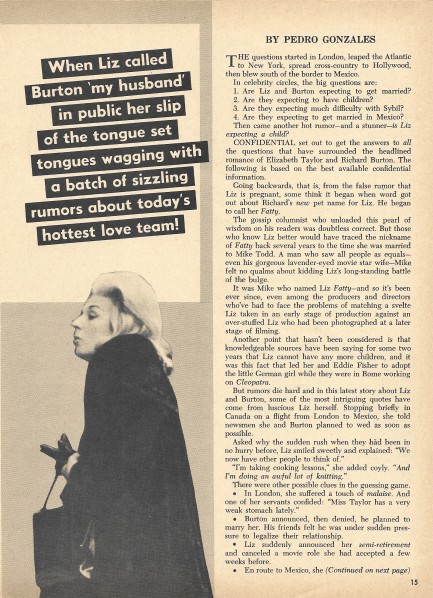 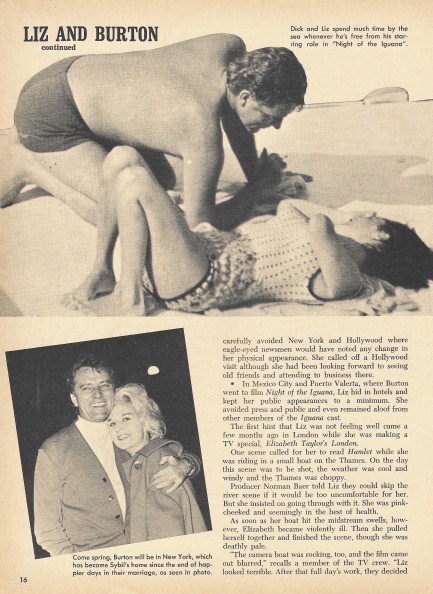 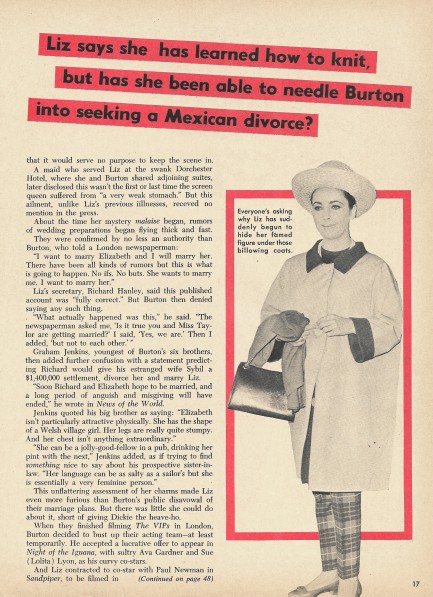   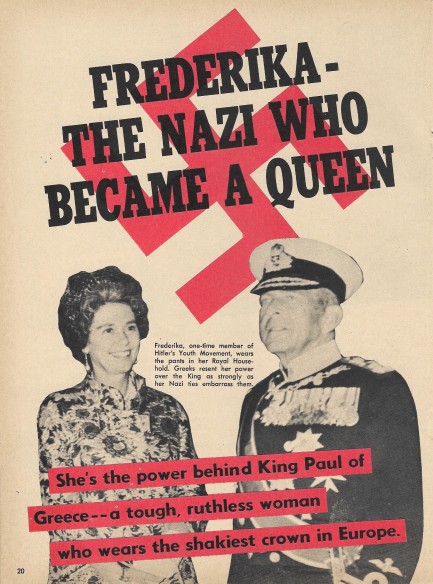 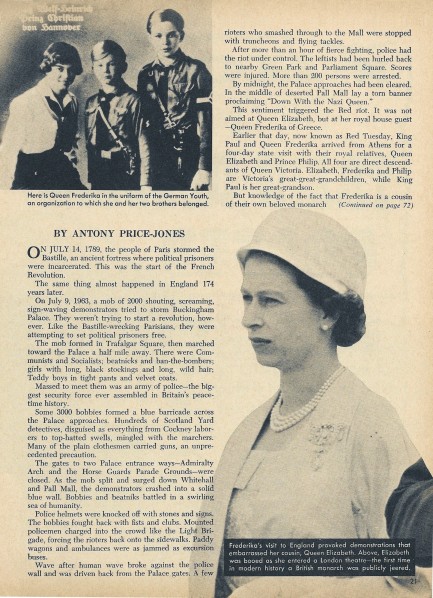    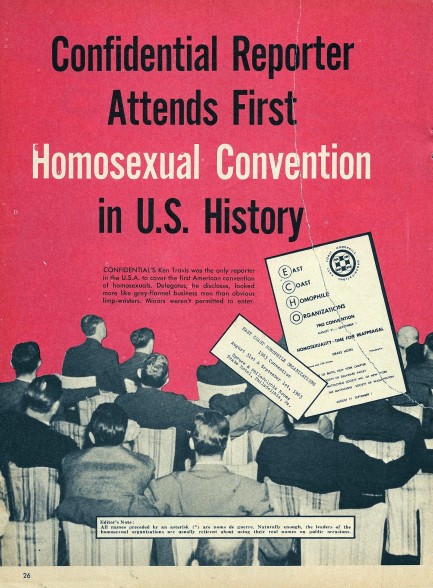  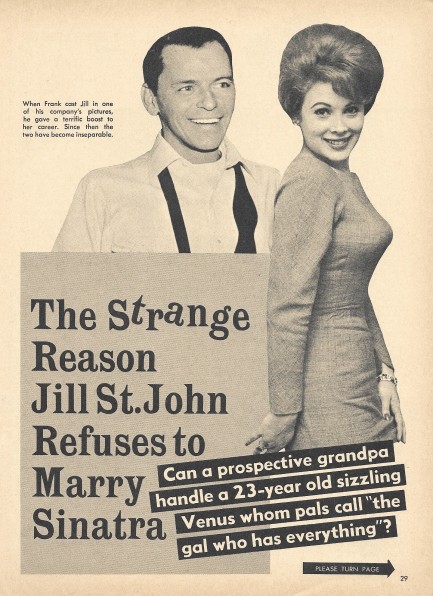 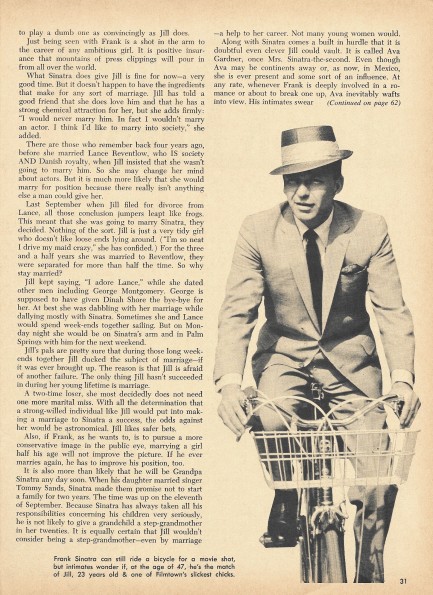  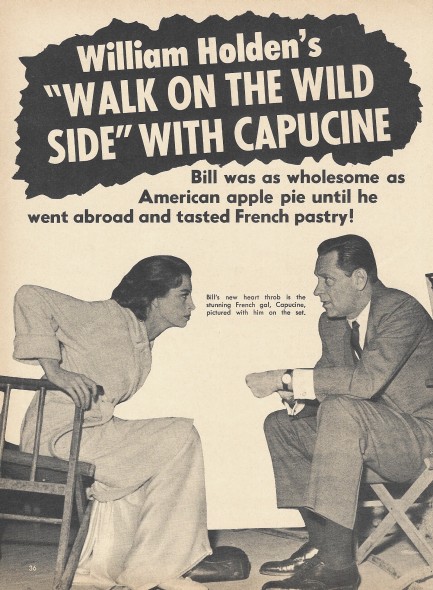 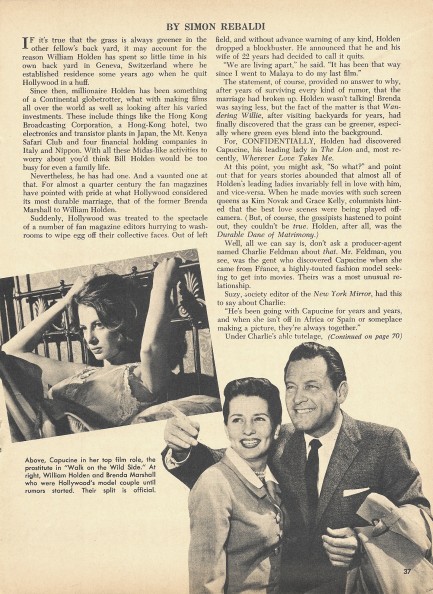 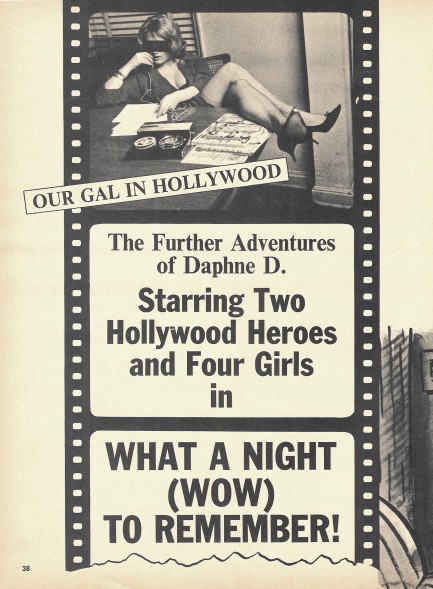 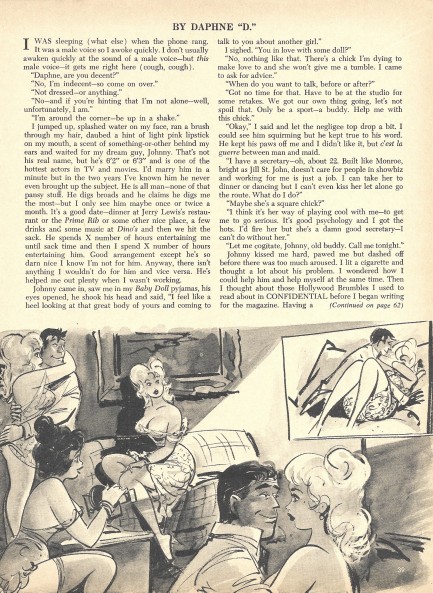  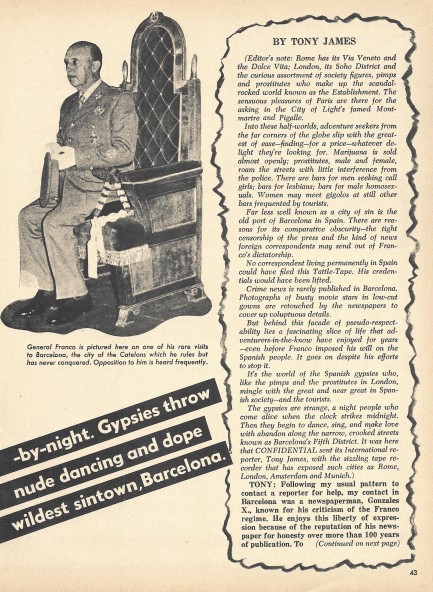 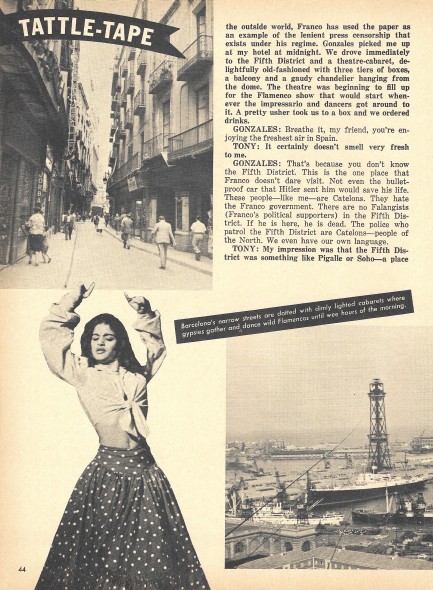
 Thanks for rescuing me. Don't untie me yet, though. First let me tell you about this kinky fantasy I've always had. 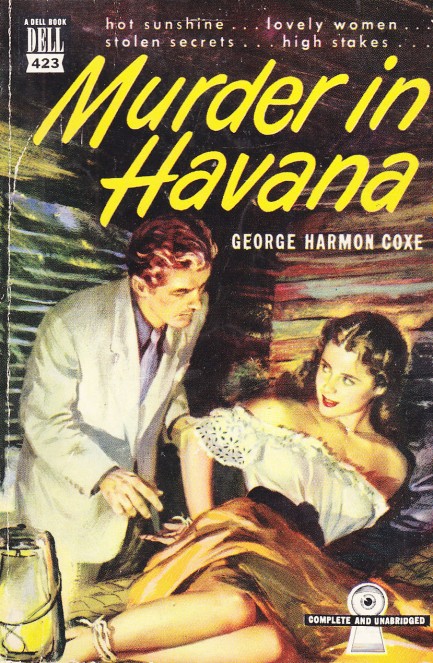
George Harmon Coxe's Murder in Havana was an easy buy for us—it was cheap and set in an exotic land. We were also drawn by its World War II backdrop, which made us fully expect Nazis, and we got them. The story concerns Andrew Talbot, who's in charge of a secret shipbuilding project. While he's out on the town someone breaks into his hotel room but somehow ends up dead five floors below. Talbot is relieved not to have been robbed of his top secret dox, but once he realizes the dead man hadn't been the only person in his room and his papers were photographed rather than stolen, he sets out to save his professional reputation and unmask the spies. As required from this sort of tale, the hero meets a couple of beautiful women, interfaces fractiously with the local cops, gets knocked over the head, and drinks rum. Mysteries from this era can be wordy, but Coxe deserves credit—he keeps the action moving around Havana and avoids the pointless reiterations that can slow these books. The ending is fun, and multi-layered. There could be more local color and travelogue, and we aren't sure if we accept the idea of skeleton keys being purchaseable on the street, but overall Murder in Havana is quite entertaining. It was published in 1943 originally, with this Dell edition and its Barye Phillips cover art of a woman bound but incongruously smiling coming in 1950.
 If he's German we're a couple of Midwestern turkey farmers. 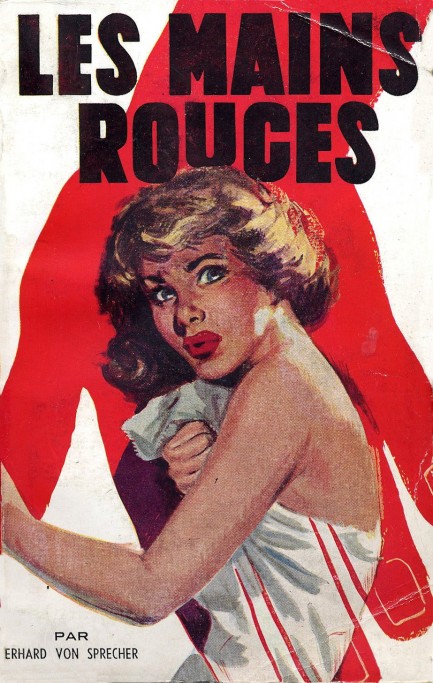
Erhard von Sprecher, author of 1954's Les mains rouges, or “red hands,” is a pseudonym. Has to be, right? French mid-century policier and espionage authors loved pen names, so much so that few of the authors wrote under their real names. We're not sure why, but we suspect that they felt it gave their books credibility if they adopted American sounding names like Patrick Rock (Louis Valgrand), Jerry Lewray (Louis de la Hattais), Slim Harrisson (Jacques Dubessy), et al. In this case, the name von Sprecher was used to give this tale about an S.S. agent who refuses to admit the Third Reich lost World War II a sense of firsthand German reality, but he was almost certainly a French writer—though one so obscure there's no information out there. Maybe something will turn up later. In any case, we decided to feature this book not because of von Sprecher's name, interesting as that is, but because of the striking red hand art. And guess what? We can't find out who did that either. C'est comme cela que ça se passe.
 Leave it to Nazis to turn phys ed from your favorite class into the worst experience of your life. 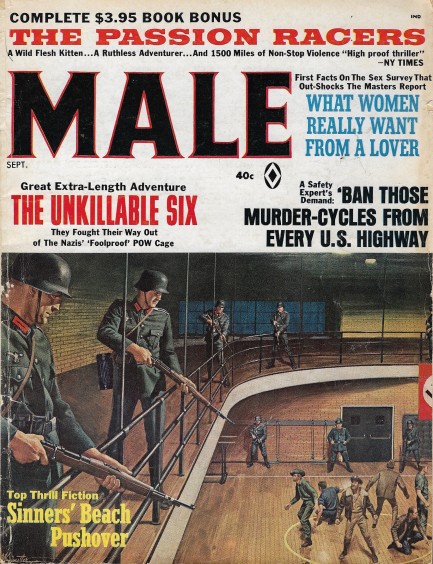
This cover of Male from this month in 1967 has cover art of history's worst gym class, painted by the great Mort Kunstler, and leave it to Nazis to ruin the one thing you can get a good grade in just by showing up. Another thing ruined is the magazine. When it arrived it turned out some pages were razored out of the center. Probably the most interesting pages. It's an occupational hazard, we suppose. We generally assume the seller had no idea, as these mags are so often the leftovers of fathers and grandfathers, but if it was in fact deliberate, well then, cocks on their house! That's the saying, right? Or it pox? Doesn't matter. The silver lining was that we didn't have to worry keeping the magazine intact while scanning. We just ripped it apart, which sort of felt good.
There's still plenty of interesting material inside this mutilated Male. There's fiction and fact, art from Gil Cohen and Bruce Minney, plus more from Kunstler, a screed against motorcycles, a lot of pro Vietnam War content, with lots of digs at peace activists and draft fugitives. The magazine works especially hard to convince readers that draftees who fled to Canada faced lives worse than if they'd gone to Southeast Asia. We doubt quite seriously that anything could be worse than dying in a hot jungle for no rational purpose 10,000 miles from home. But maybe we're biased—our fathers were war vets, and they had one wish in life: that the military never get its mitts on us. Also that we never do hard drugs. Well, one out of two isn't bad. Twenty scans below. 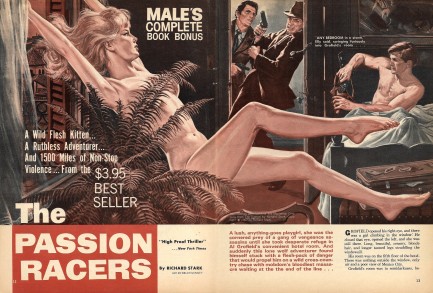  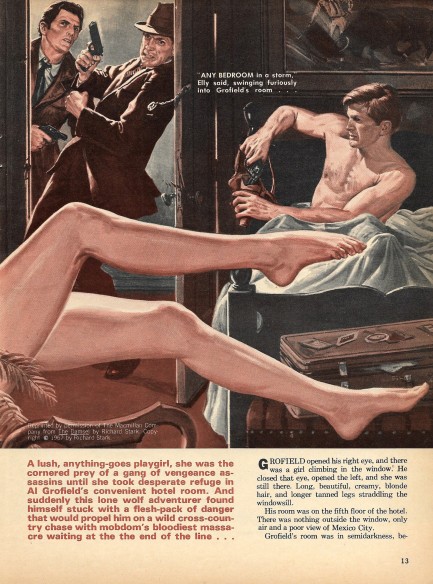 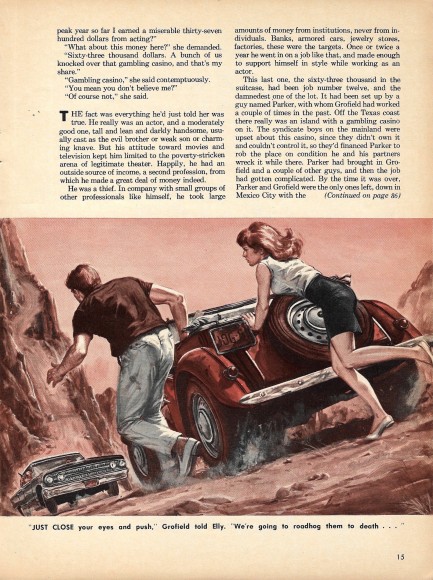   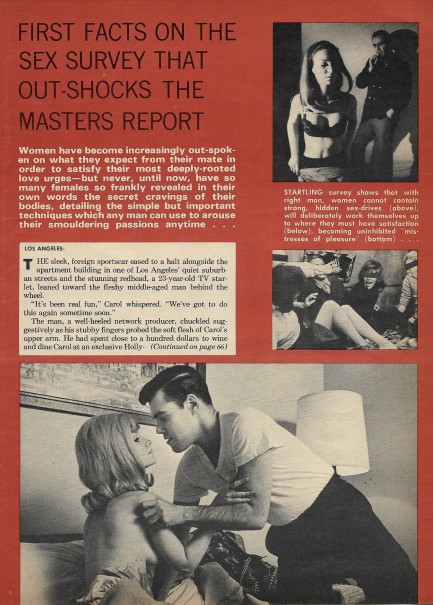 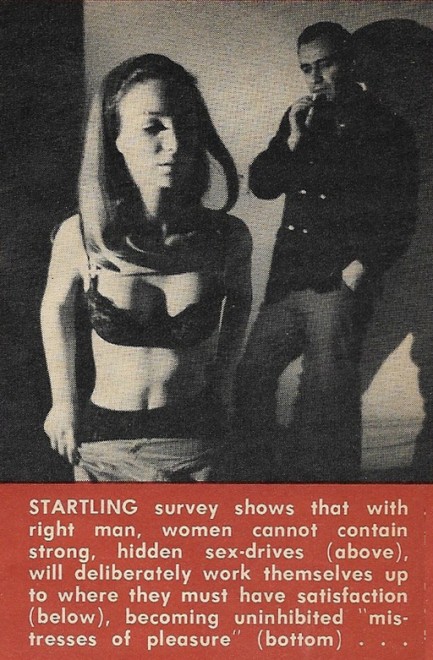    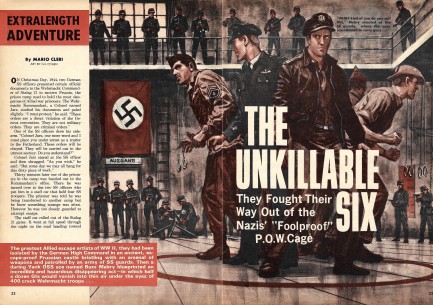 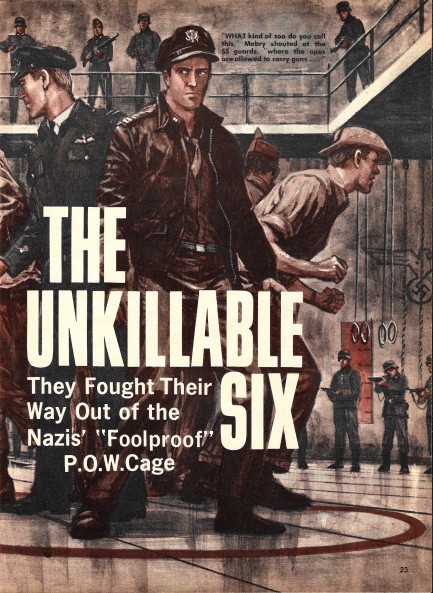 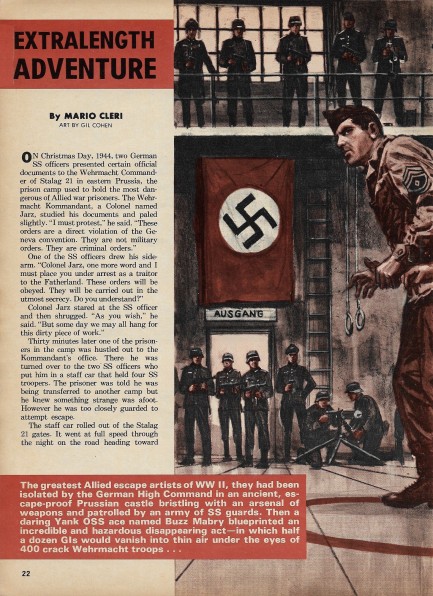    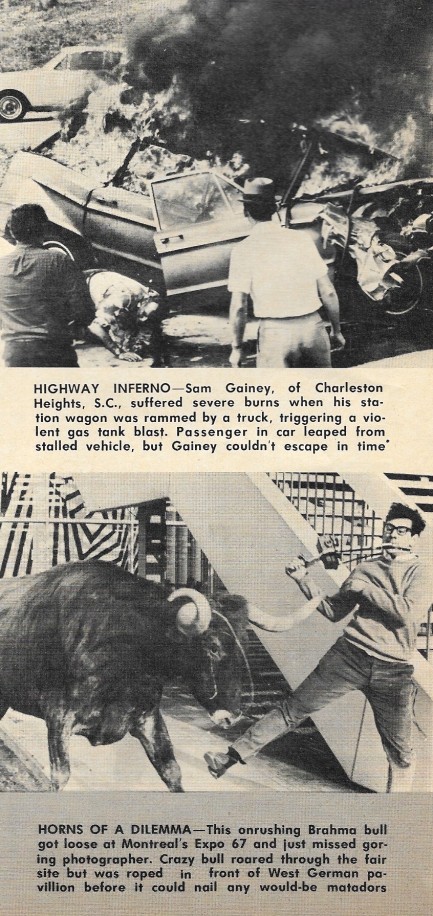  

|
 |

The headlines that mattered yesteryear.
2003—Hope Dies
Film legend Bob Hope dies of pneumonia two months after celebrating his 100th birthday. 1945—Churchill Given the Sack
In spite of admiring Winston Churchill as a great wartime leader, Britons elect
Clement Attlee the nation's new prime minister in a sweeping victory for the Labour Party over the Conservatives. 1952—Evita Peron Dies
Eva Duarte de Peron, aka Evita, wife of the president of the Argentine Republic, dies from cancer at age 33. Evita had brought the working classes into a position of political power never witnessed before, but was hated by the nation's powerful military class. She is lain to rest in Milan, Italy in a secret grave under a nun's name, but is eventually returned to Argentina for reburial beside her husband in 1974. 1943—Mussolini Calls It Quits
Italian dictator Benito Mussolini steps down as head of the armed forces and the government. It soon becomes clear that Il Duce did not relinquish power voluntarily, but was forced to resign after former Fascist colleagues turned against him. He is later installed by Germany as leader of the Italian Social Republic in the north of the country, but is killed by partisans in 1945.
|

|
|

It's easy. We have an uploader that makes it a snap. Use it to submit your art, text, header, and subhead. Your post can be funny, serious, or anything in between, as long as it's vintage pulp. You'll get a byline and experience the fleeting pride of free authorship. We'll edit your post for typos, but the rest is up to you. Click here to give us your best shot.

|
|


 Above you see a cover effort by Gerald Gregg for Helen McCloy's 1945 mystery The Man in the Moonlight. This is from Dell Publications, and you probably recognized it right away as a mapback edition. You see that here too, with its fictive university campus.
Above you see a cover effort by Gerald Gregg for Helen McCloy's 1945 mystery The Man in the Moonlight. This is from Dell Publications, and you probably recognized it right away as a mapback edition. You see that here too, with its fictive university campus.











 people must pay them, yet the rich and powerful somehow always manage to avoid their fair share, even when they've generated their loot through illegal or even genocidal means. As with many morally rudderless institutions and people, what Swiss banks do is perfectly legal, but “perfectly legal” is the phrase uttered by people who know they're willfully engaged in behavior that obviously should be illegal—and in fact is illegal for everyone but the rich and connected.
people must pay them, yet the rich and powerful somehow always manage to avoid their fair share, even when they've generated their loot through illegal or even genocidal means. As with many morally rudderless institutions and people, what Swiss banks do is perfectly legal, but “perfectly legal” is the phrase uttered by people who know they're willfully engaged in behavior that obviously should be illegal—and in fact is illegal for everyone but the rich and connected. came out of jail not disgraced and shunned, but welcomed, feted, and once again demanding and receiving VIP treatment, the best tables in the best restaurants, and the ear of the global elite. He threw a few coins to charity along the way to spit-shine his reputation, had his thriving conglomerate Talaat Moustafa Group donate some COVID vaccines, but still he's a murderer who wriggled loose from the hangman's noose, and today enjoys every privilege he ever enjoyed—while his victim is dead forever.
came out of jail not disgraced and shunned, but welcomed, feted, and once again demanding and receiving VIP treatment, the best tables in the best restaurants, and the ear of the global elite. He threw a few coins to charity along the way to spit-shine his reputation, had his thriving conglomerate Talaat Moustafa Group donate some COVID vaccines, but still he's a murderer who wriggled loose from the hangman's noose, and today enjoys every privilege he ever enjoyed—while his victim is dead forever.























































































































